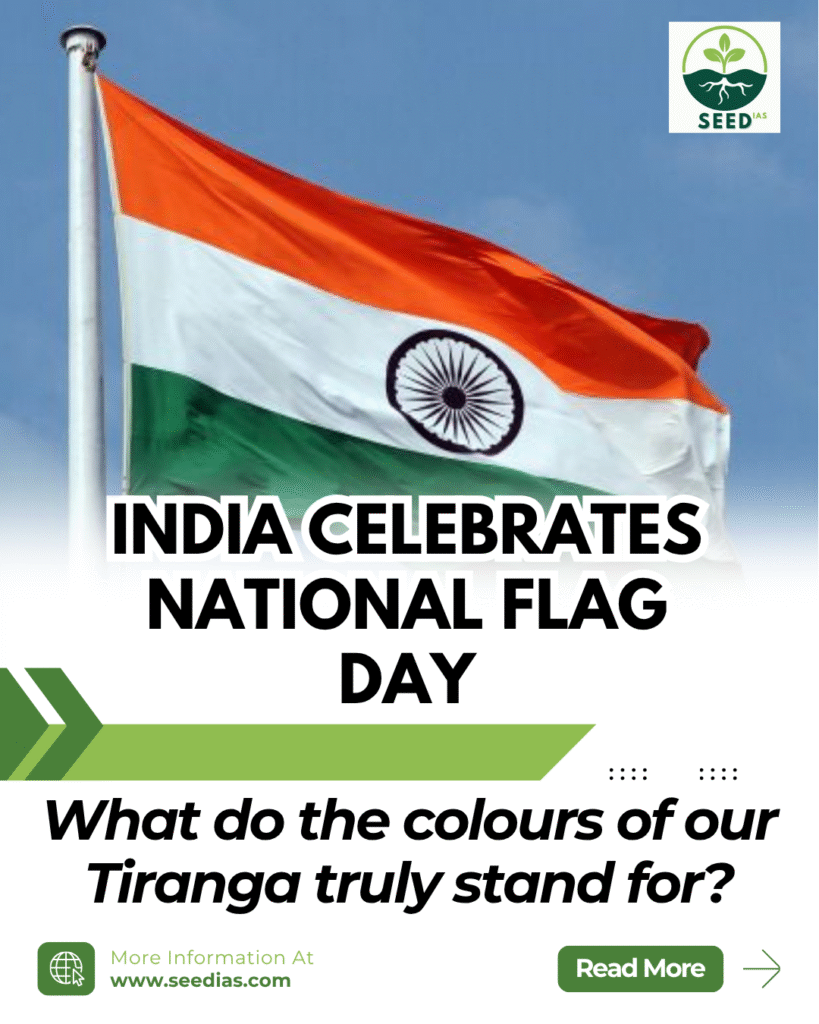Why in NEWS
India observed National Flag Day on 22nd July 2025 to commemorate the adoption of the Indian National Flag by the Constituent Assembly in 1947.
Key Terms and Concepts
| Term | Explanation |
|---|---|
| Tiranga | The common name for the Indian National Flag, meaning tricolour |
| Ashoka Chakra | Navy blue 24-spoke wheel in the flag’s center, from the Lion Capital at Sarnath |
| Flag Code of India, 2002 | Set of guidelines for display and use of the national flag |
| Article 51A(a) | Constitutional duty of citizens to respect the National Flag and Anthem |
| Prevention of Insults to National Honour Act, 1971 | Penal provisions against disrespect to the national flag and anthem |
Evolution of the Indian National Flag
| Year | Milestone |
|---|---|
| 1904 | Sister Nivedita’s flag: red and yellow with Vajra and lotus |
| 1906 | Calcutta Tricolour: green, yellow, red stripes with symbols |
| 1907 | Bhikaji Cama’s flag in Germany: green, saffron, red stripes with symbols |
| 1917 | Home Rule Flag by Annie Besant and Tilak: Red and green with Union Jack and Saptarishi stars |
| 1921 | Pingali Venkayya’s design: red, white, green with charkha |
| 1931 | Final Congress version: saffron, white, green with charkha |
| 1947 | Present flag adopted: spinning wheel replaced by Ashoka Chakra |
Current Design and Symbolism
| Element | Meaning |
|---|---|
| Saffron | Courage and sacrifice |
| White | Peace, truth, and honesty |
| Green | Fertility and prosperity |
| Ashoka Chakra | Law, movement, justice, and the wheel of dharma |
| Dimensions | 3:2 (length to height) |
Flag Code of India, 2002
| Feature | Details |
|---|---|
| Enforced From | 26 January 2002 |
| Structure | Three parts: flag description, public/institutional use, government display |
| 2022 Amendment | Flags allowed day and night if displayed outdoors or at homes |
| Do’s | Citizens can hoist the flag any day with dignity; educational use promoted |
| Don’ts | Cannot touch ground, water, or be used as drapery or clothing; cannot cover vehicles or be flown below other objects |
Notable Facts
| Item | Description |
|---|---|
| Oldest Surviving Flag | Preserved at Fort St. George Museum, Chennai; hoisted on 15 August 1947 |
| Material | Traditionally khadi; now allowed in polyester and machine-made forms |
| Designer of Final Flag | Largely credited to Pingali Venkayya |
In a Nutshell
Mnemonic: “TIRANGA”
Timeless symbol of unity and pride
India’s identity in colours and law
Represents values: peace, courage, prosperity
Ashoka Chakra brings motion to life
Nationwide right to hoist with respect
Guided by Flag Code and Constitution
Amended for wider, respectful display
Prelims Practice Questions
- Who proposed the 1921 version of the Indian National Flag featuring the spinning wheel?
A. Annie Besant
B. Bhikaji Cama
C. Pingali Venkayya
D. Mahatma Gandhi - As per the Flag Code of India, 2002, what is the correct flag ratio?
A. 4:3
B. 2:1
C. 3:2
D. 2:3 - The Ashoka Chakra in the Indian Flag is derived from which historical monument?
A. Ashoka Pillar, Delhi
B. Lion Capital of Ashoka, Sarnath
C. Ajanta Caves
D. Khajuraho Temple
Mains Questions
- Trace the evolution of the Indian National Flag and its symbolic significance in modern India. (10M)
- What are the key provisions of the Flag Code of India, 2002? Discuss how recent amendments have made the flag more accessible to citizens. (15M)
Answer Key with Explanations
| Qn | Answer | Explanation |
|---|---|---|
| 1 | C | Pingali Venkayya proposed the spinning wheel flag in 1921 |
| 2 | C | The correct ratio is 3:2 (length to height) |
| 3 | B | Ashoka Chakra is taken from the Lion Capital at Sarnath |
















